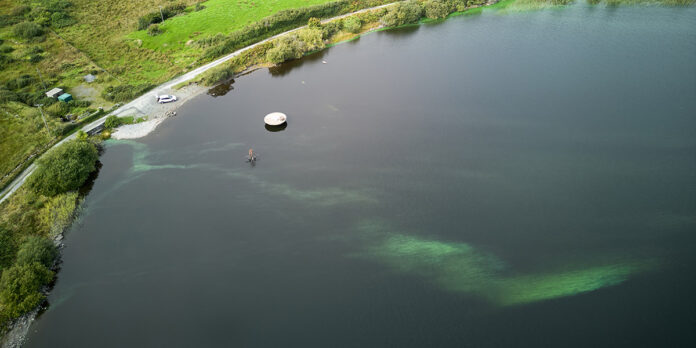Despite reassurances from Uisce Éireann in recent days that the water supply in North Clare is safe to drink, many hundreds of people are refusing to drink the tap water in the area, complaining of issues with taste and a strong odour.
Just outside of Ennistymon, Lickeen Lake supplies the Ballymacravan Water Treatment System which provides drinking water to more than 14,000 people in the North Clare area.
In early August of this year, a large algae bloom was recorded on the lake. The emergence of this bloom of blue and green algae coincided with a flood of complaints from the people of North Clare about the taste and smell of their drinking water.
While algae blooms occur naturally, they are often associated with instances of pollution, especially when excessive nutrients such as nitrogen and phosphorus enter a waterway.
This can happen when chemical fertiliser or animal slurry is washed from farmland into nearby waterways.
North Clare resident and hydrology expert, Féidhlim Harty, says that while he doesn’t have any specific information about Lickeen Lake, there is a number of dangers associated with algal blooms.
“Some algae is edible, some are toxic and will kill you if you consume too much of them, and many are probably in between,” he told The Clare Champion.
“My understanding is that cyanobacteria, the blue-green algae is a toxic one, caused by excessive nutrient inputs, usually from agriculture, septic tanks and sewage treatment systems. But it is important to say that I do not know whether there is cyanobacteria in Lickeen Lake at the moment. I don’t know what is going on at the lake at the moment, other than the fact that my drinking water doesn’t taste good.”
According to Mr Harty, even before the presence of algae, excessive nutrients in a waterway can cause serious health issues.
“If there is excessive nitrates and phosphorates in the water it does a number of things. For a start it reduces the usefulness so the water for a whole range of species,” he said.
“If the nitrates go above a certain level, that can result in a syndrome known as methemoglobinemia, also known as blue-baby syndrome. The likelihood also is that if there are raised levels of nitrates and phosphates, there are likely to be other things present in the water as well. There will be pathogenic microbes and potentially other toxins.
“If the contamination is coming from domestic sources, then there is potentially grey-water chemicals getting in and also heavy metals. If it is coming from agriculture, there is potential for all sorts of biocides to be present. Biocides are what it says on the tin, they are designed to kill things that are alive, and in our drinking water that includes me and you.”
While no source for the bloom at Lickeen Lake has yet been identified, due to a lack of housing in the catchment area, it is unlikely to have come from domestic sources.
“My understanding is that a lot of the Lickeen Lake catchment is under sitka spruce forestry and there is a few potential issues with that. One is that when this forestry is planted, the draining works that go into the preparation tend to produce silt. The sprays that are used, such as Round-up which is a recognised carcinogenic, causes trouble. The third is if it fertiliser is added, nitrates and phosphates can get into the water and contribute to the growth of algae,” said Mr Harty.
“Clear-felling of trees means that we rip up the soil as well. If we were to shift to continuous cover forestry, we would remove the most valuable trees, but leave the others to grow on and increase in value, but also to protect the soil and protect the waterways.”
While the majority of waterways in Clare are currently classified as being of low quality, a number of simple and inexpensive measures could tackle this situation.
“An awful lot can be done to solve this. When it comes to domestic septic tanks, we have poor soils in North Clare, soakage into the ground is actually very limited. The potential for run-off is very high. One thing that can be done is to replace existing failed percolation areas with willow planted percolation areas which aren’t currently in the EPA code,” said Mr Harty.
“There is a very simple method where the layout of the percolation area could be changed to prevent the willow roots from blocking the pipes. The willow mops up the excessive nutrients but also the roots open up the pathways in the soil, helping to increase the percolation.
“The easiest measure for agriculture is to stop draining farm drains, to let the plants remain and be a filter system. Beyond that would could widen farm drains, put in silt traps, wetland planted pools and areas where the water can lie in the landscape and slow down. A lot of these measures will be funded soon under the Waters EIP Project. But how to get the uptake on that will be the challenge.”
Uisce Éireann declined to contribute to this article.
Andrew Hamilton is a journalist, investigative reporter and podcaster who has been working in the media in Ireland for the past 20 years. His areas of special interest include the environment, mental health and politics.


